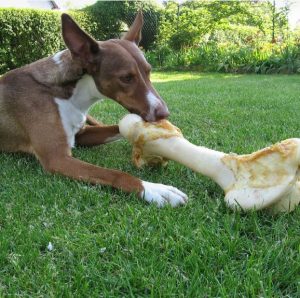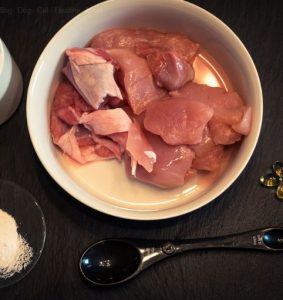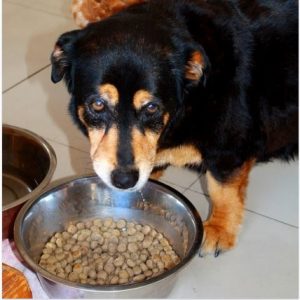Dogs can be allergic to a variety of substances, but dog allergies to meat protein are quite common. If you suspect your dog is suffering from some food allergy, see your vet. Your vet is the best person to help you pinpoint the problem and take action so that your dog can feel better and enjoy life as he should. Following is a guide for dogs allergic to meat proteins, by veterinarian Dr. Ivana Vukasinovic.
By Ivana Vukasinovic, DVM
 Understanding Food Allergies in Dogs
Understanding Food Allergies in Dogs
The word allergy is from Greek language and means different (alos). Allergy is a different body reaction (overreaction), to a substance or particle, which is otherwise harmless, but in this case leads to sensitization.
It is necessary to distinguish between two different concepts, or two clinical manifestations: food allergies and food intolerance.
A food allergy is a process mediated by IgE antibodies against food proteins, and manifested in the rapid cause-effect reaction and requires previous exposure to the allergen.
A food intolerance is a reaction to food that can cause unpleasant symptoms and many chronic conditions is associated with intolerance, but it does not involve the immune system nor its reaction, and can occur with the first contact with certain food.
The Making of a Food Allergy 
The first contact with a food product does not lead to an allergic reaction; but the new particle is now recognized as foreign matter – antigen, and as a response, body generates antibodies.
Reintroduction of the same food can cause an allergic reaction. Then, the reaction between Antigen (food) and Antibodies (created at the first entry of the substance inside the body) liberates substances that deplete the tissue and give allergy symptoms.
The compound of Ag-Ab activates mast cells and leads to their degranulation- spraying and liberating the histamine. Most of these cells are located in the mucous membranes of the digestive tract, and in the skin, and these two organs are the first to react with allergic symptoms.
Allergies to Meat Proteins 
In a healthy organism, food breaks down into the simplest parts such as single amino acids, and in the gastrointestinal tract these nutrients are absorbed into the bloodstream. The GI tract is very important player in primary allergic defense. If too big particles of digested food pass into the bloodstream, it will trigger a massive allergic reaction.
The most common meat proteins that are likely to provoke allergic reaction are beef and chicken, probably because these two protein sources are the biggest and most common. If a dog is given chicken protein or same basic protein source every day of his life, over time his body (meaning GI tract) may become less equipped to break down those proteins.
Signs of Trouble
Manifestations of these problems are most notable on the skin and in the digestive system. One should know that almost one-third of all skin diseases in domestic carnivores occur on allergic basis.
Allergic skin changes are best recognized by redness of the skin, spots around the ears, the eyes, the feet and armpits, paw biting, obsessive licking and intense itching. If the dog is constantly infuses food that causes hypersensitivity, itching becomes stronger, scratching intensely, with formation of sores on the skin, and it provides an excellent base for the growth of various bacterial infections that can lead to other a much more serious and dangerous problems.
When we talk about symptoms in the digestive tract, the most notable occurrences are vomiting and diarrhea. Frequent vomiting and diarrhea leads to dehydration, weight loss, digestive disorders, fatigue and natural rejection of food intake.
 Did you know? The most reliable way to diagnose food allergies is a food trial in which the animal’s body takes a break from the food that’s been causing the symptoms.
Did you know? The most reliable way to diagnose food allergies is a food trial in which the animal’s body takes a break from the food that’s been causing the symptoms.
 Starting a Food Trial
Starting a Food Trial
There are two types of food trial, or so-called food elimination diet, using a novel protein food source or hydrolyzed protein. These types of diets are also called hypoallergenic.
Novel protein sources are meat sources that animal hasn’t consumed before.
Most novel proteins today are venison, bison, elk, alligator, pheasant, kangaroo, ostrich, quail and beaver, with new protein sources that are being tested and introduced every day.
When transferring dogs to this new feeding regiment, it is customary to switch carbohydrates as well and to reduce them to single source, due to the fact that plants that are the basic source for carbohydrates are proteins as well. The best preference is to keep metabolically low-stress diet, and that means no grains if possible.
Hydrolyzed proteins are the smallest molecules made from intact animal proteins fragmented down to the tiniest particles, so that the immune system cannot detect them, which prevents reaction of the immune response, and there is no allergic reaction.
Starch or rice is typically used as carbohydrate source because they are very rarely associated with allergic reactions and they are relieving symptoms of existing allergies.
No matter what type of hypoallergenic dog food we are talking about, the diet should last no less than 10 weeks, usually for about 15. Most dogs experience some improvements in the first few weeks.
Such therapy is usually very difficult for the owner, both financially and psychologically, due to the fact that hypoallergenic diets exclude treats, and they need constant attention of the owner. Veterinary diets must be prescribed and monitored by qualified person.
About the Author
DVM Ivana Vukasinovic is a veterinarian in Belgrade, capital city of Serbia.
She received her B.S from University of Belgrade in 2012, and her master’s degree from Veterinary University, Belgrade.
Before eventually becoming director of Vetanima Doo, company that sells animal food, medicine and supplements, she have worked in many different fields of sales. After finishing college, she started working as sales person in biggest Serbian bookshop chain, and being passionate about books, she had reached the position of publisher.
After leaving this field, she started working as a veterinary commercialist, and then landing a job as veterinarian at veterinary pharmacy, in the same company in which she is now acting as director.
When she is not working, she is either glued to some fantasy book or cooking for friends. She currently resides in Belgrade with her cat Mile.



 Understanding Food Allergies in Dogs
Understanding Food Allergies in Dogs 


 Starting a Food Trial
Starting a Food Trial DVM Ivana Vukasinovic is a veterinarian in Belgrade, capital city of Serbia.
DVM Ivana Vukasinovic is a veterinarian in Belgrade, capital city of Serbia.